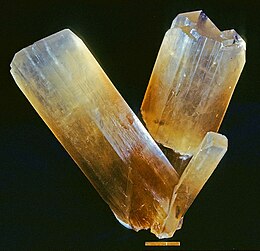Borax (Na2B4O5(OH)4 · 8 H2O[2]) is a borate mineral found in evaporite deposits of alkaline lacustrine environments and as a surface efflorescence in arid regions. It is the chief mineral mined from the deposits at Boron, California and nearby locations, and is the chief source of commercial borax.[5]
| Borax | |
|---|---|
 Borax from the Kramer Borate deposit, Boron, Kern Co, California, USA | |
| General | |
| Category | Nesoborate |
| Formula (repeating unit) | Na2B4O5(OH)4·8H2O |
| IMA symbol | Brx[1] |
| Strunz classification | 6.DA.10 |
| Crystal system | Monoclinic |
| Crystal class | Prismatic (2/m) (same H-M symbol) |
| Space group | C2/c (no. 15) |
| Unit cell | a = 11.8790(2) Å, b = 10.6440(2) Å, c = 12.2012(2) Å; β = 106.617(1)°; Z = 4 |
| Identification | |
| Color | Colorless or white |
| Crystal habit | As prismatic crystals or as massive encrustations |
| Twinning | Rare on {100} |
| Cleavage | Perfect on {100}, less perfect on {100}, very poor on {010} |
| Fracture | Conchoidal |
| Mohs scale hardness | 2 to 2.5 |
| Luster | Vitreous to resinous to earthy |
| Streak | White |
| Diaphaneity | Translucent to opaque |
| Specific gravity | 1.715 |
| Optical properties | Biaxial (-) |
| Refractive index | nα = 1.4466 nβ = 1.4687 nγ = 1.4717 |
| Fusibility | 1.5 |
| Diagnostic features | Froths on heating, producing a yellow flame |
| Solubility | Soluble in water |
| References | [2][3][4][5] |
Borax first reached Western civilization as tincal mined from deposits in Tibet.[5] The term borax comes from the Arabic bauraq, meaning white.[3]
Occurrences
editThe most extensive deposits are in Kirka, Turkey. Borax is also mined in the Andes Mountains of Argentina, Bolivia, and Chile. However, the greatest production is from the deposits in California.[5]
Uses
editNatural occurrences of the mineral are an important source of commercial borax, which is used for the manufacture of glass fibers, in cleaning agents, as an antiseptic, and as a flux in metallurgy and solvent for metal oxides.[5]
See also
editReferences
edit- ^ Warr, L.N. (2021). "IMA–CNMNC approved mineral symbols". Mineralogical Magazine. 85 (3): 291–320. Bibcode:2021MinM...85..291W. doi:10.1180/mgm.2021.43. S2CID 235729616.
- ^ a b Anthony, John W.; Bideaux, Richard A.; Bladh, Kenneth W.; Nichols, Monte C. (2005). "Borax" (PDF). Handbook of Mineralogy. Retrieved 17 June 2022.
- ^ a b "Borax". Mindat.org. Retrieved 17 June 2022.
- ^ Sinkankas, John (1964). Mineralogy for amateurs. Princeton, N.J.: Van Nostrand. pp. 382–383. ISBN 0442276249.
- ^ a b c d e Klein, Cornelis; Hurlbut, Cornelius S. Jr. (1993). Manual of mineralogy: (after James D. Dana) (21st ed.). New York: Wiley. pp. 421–422. ISBN 047157452X.